Untitled Document

|
Cheese Categories
Cheese can be classified into various categories or families based on how they are made and similarities of appearance and flavor. It is important to note, however, that not all cheeses within a particular category will taste the same, and that some cheeses can be placed in more than one category. Also, there are many methods used to classify cheese. Below, we classify cheese as is done in Germany.
The various cheese categories are listed and described below. To search for cheese belonging to a particular cheese category, use our dictionary search (to the right). |
|
Fresh, Unripened Cheese (Frischkäse)
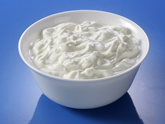
Photo: © Philipp Meyer - Fotolia.com |
|
These are cheeses that have not gone through a maturing (ripening) process. They are made from pasteurized milk, and the milk is simply curdled and drained, with minimal processing. They are usually soft and spreadable, mild in taste, have varying fat contents, and have a high water content (over 73%). They are easily used in recipes, in both cold and hot dishes, as well as in baking. Examples includes Quark, Cottage Cheese, Cream Cheese, Ricotta Cheese, and fresh goat's milk Chevre.
Fresh, traditional Mozzarella also can be classified as Fresh Cheese. Fresh curds are formed into balls, and traditionally eaten within a few hours of being formed.
Soft Cheese with Flowery Rind (Weichkäse mit Aussenschimmel)
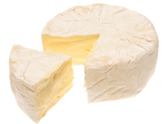
Photo: © Richard Griffin - Fotolia.com |
|
These chesses are soft, creamy, and a pale-yellow in color. They are made by allowing a white mold (Penicillium Candida) to grow on the outside for a few days. The mold forms a white rind and helps create the smooth texture. When these cheeses are at their peak, they bulge out from beneath their rind when they are cut. The most popular of soft cheese are Camembert and Brie. Others include the Italian Formagella, and the French Caree de l'Est, Coulommiers, and Chaource.
Soft cheeses work well in both cold and hot dishes. They are also often enjoyed for dessert.
Soft Cheese with Washed Rind (Weichkäse mit gewaschener Rinde)
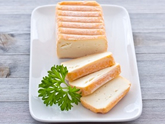
Photo: © victoria p. - Fotolia.com |
|
During their aging period, these cheeses are regularly washed in salt water, making their surfaces permeable to a certain reddish-orange bacteria. This process gives the cheese a brown rind, a distinctive flavor, and a very strong aroma.
The best known cheese is this category is Limburger. Other cheeses in this category include Munster, Chaumes, and Romadur.
Sour Curd Cheese (Sauermilchkäse)
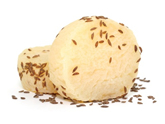
Photo: © photocrew - Fotolia.com |
|
These cheeses belong to the oldest kinds of cheese. Traditionally, these cheeses were made in home kitchens - when milk curdled and got thick, the thick milk was formed into small rolls by hand. They were then placed next to a warm stove to dry and ripen. Today, cheese factories use micro-organisms to obtain the curdling effect. The cheese is then ground down, seasonings such as salt or caroway seeds are added, and the cheese is formed into rolls by machine. The cheese is temporarily stored in a very warm, humid room to develop its flavor.
In Germany, cheeses of this category are further divided into two kinds:
Yellow Cheese (Gelbkäse) - During their aging process, these cheeses are smeared with a yellow or red bacteria. This process give the cheese a distinctive flavor and strong aroma. In this group belong Harzer Cheese (Harzer Rolls) and Mainzer Cheese.
Sour Curd Cheese With Flowery Rind (Sauermilchkäse mit Edelschimmel) - These are milder in taste and in smell than the Gelbkäse. During their aging process, they are made by allowing a white mold to grow on its surface. Chesses in this group include Handkäse, Bauernhandkäse, Korbkäse, Kochkäse, Stangenkäse, and Spitzkäse.
Semi-Hard, Sliced Cheese (Halbfester Schnittkäse)
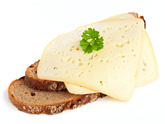
Photo: © Quade - Fotolia.com |
|
The cheeses in this category are usually young and have a moisture content that ranges from 63 - 69%. Their semi-firm texture makes them easily slicable, which make them good for sandwiches.
Cheeses in this category include Tilsiter and Butterkäse.
Hard, Sliced Cheese (Schnittkäse)
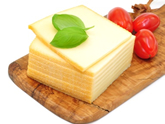
Photo: © photocrew - Fotolia.com |
|
These cheeses are made from either raw or pasturized milk, and they ripen in 3 to 6 months. Their moisture content ranges from 54 - 63%. The curds are packed into a mold, then pressed mechanically.
This category of cheeses includes Gouda, Appenzeller, Raclette, and Edamer.
Extra Hard Cheese (Hartkäse)
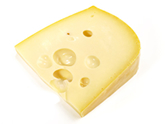
Photo: © ExQuisine - Fotolia.com |
|
These cheeses are also pressed into a mold, but are heated first. They are then aged for 2 to 3 years. Their low moisture content (up to 56%) makes them firmer than other cheeses. They work well in both cold and hot dishes - they can be sliced, crumbled, and grated. This category includes Parmigiano Reggiano, Gruyere, Emmentaler, Bergkäse from the Allgäu region, Sbrinz, and Pecorino.
Blue Vein Cheese (Blauschimmelkäse)
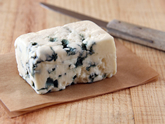
Photo: © kristina rütten - Fotolia.com |
|
These cheeses are loosely pressed, then injected with a Pennicillium spore. The mold grows within the cheese, giving the cheese the internal blue, blue-black, or green veining and its tangy flavor. These cheeses can be soft or firm/crumbly. Cheeses in this category include Bavarian Blu, Edelpilzkäse, Roquefort, Gorgonzola, and Stilton.
Goat's Milk Cheese (Ziegenkäse)
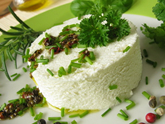
Photo: © Heike Rau - Fotolia.com |
|
More wholesome than cow's milk because of its higher protein and fat content, these cheeses come in soft and firm textures. They all have a unique flavor - different from cow's milk.
This category includes Tomme de Chèvre, Ibores, and Majorero.
Sheep's Milk Cheese (Schafkäse)
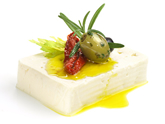
Photo: © ExQuisine - Fotolia.com |
|
Like goat's milk cheese, these cheeses taste quite different than cow's milk cheeses. Some are mild, yet others can be quite sharp in flavor. Many traditional Greek cheeses fall into this category, such as Feta. Other cheeses in this category include Isartaler, Pecorino, and Manchego.
|
|
|

